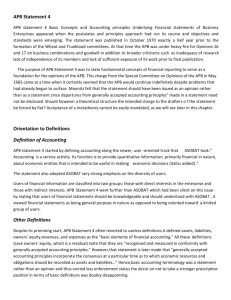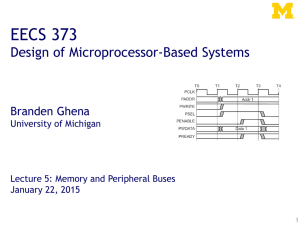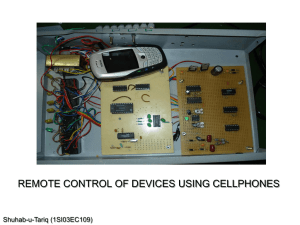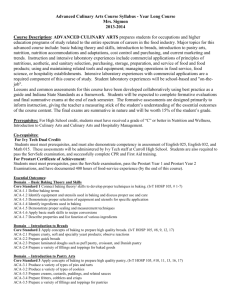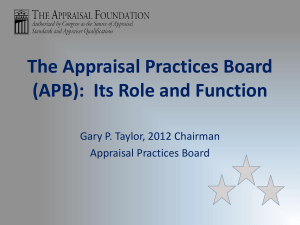PreLab 3 Submission Form
advertisement
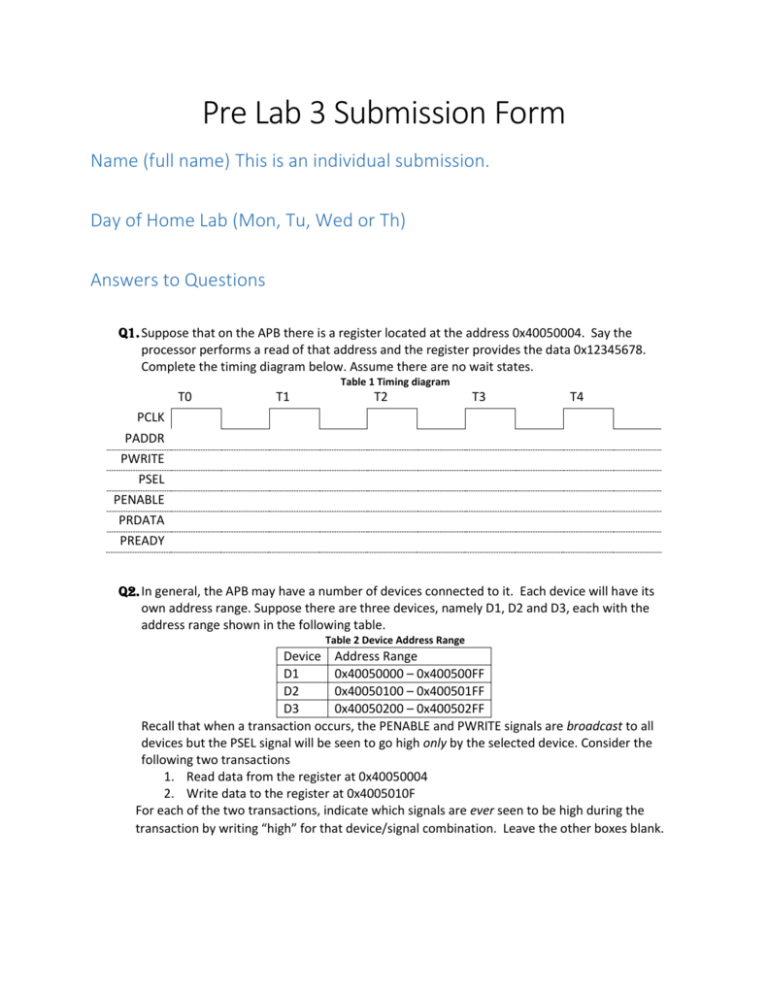
Pre Lab 3 Submission Form
Name (full name) This is an individual submission.
Day of Home Lab (Mon, Tu, Wed or Th)
Answers to Questions
Q1. Suppose that on the APB there is a register located at the address 0x40050004. Say the
processor performs a read of that address and the register provides the data 0x12345678.
Complete the timing diagram below. Assume there are no wait states.
Table 1 Timing diagram
T0
T1
T2
T3
T4
PCLK
PADDR
PWRITE
PSEL
PENABLE
PRDATA
PREADY
Q2. In general, the APB may have a number of devices connected to it. Each device will have its
own address range. Suppose there are three devices, namely D1, D2 and D3, each with the
address range shown in the following table.
Table 2 Device Address Range
Device Address Range
D1
0x40050000 – 0x400500FF
D2
0x40050100 – 0x400501FF
D3
0x40050200 – 0x400502FF
Recall that when a transaction occurs, the PENABLE and PWRITE signals are broadcast to all
devices but the PSEL signal will be seen to go high only by the selected device. Consider the
following two transactions
1. Read data from the register at 0x40050004
2. Write data to the register at 0x4005010F
For each of the two transactions, indicate which signals are ever seen to be high during the
transaction by writing “high” for that device/signal combination. Leave the other boxes blank.
Table 3 APB Signals
Transaction 1 Device
PSEL
PENABLE
PWRITE
PSEL
PENABLE
PWRITE
D1
D2
D3
Transaction 2 Device
D1
D2
D3
Q3. Consider your answers to questions Q1 and Q2 when answering the following questions.
Throughout this problem, assume there are no wait states.
a. Say a device is being written to by the processor. Look at figure 2-1 of the APB protocol
specification. On which clock edge (T0, T1, T2 etc.) should the I/O device actually
perform the write to its register? Why?
b. Say a device is been read by a processor. Look at figure 2-3 of the APB protocol
specification.
i. On which clock edge(s) must the I/O device supply data?
ii. On which clock edges is it allowed to supply data1?
c. Now, using only the signals PSEL, PENABLE and PWRITE as inputs, write equations for
when the device should write to its register (write_enable) and supply its data
(read_enable). Assume on a read that you should only supply data when the APB
specification says you can. (Note, you can actually supply the data at all times because
the APB master will ignore it. That is because each device has its own PRDATA bus.)
write_enable =
read_enable =
Q4. PREADY is a signal each device sends to the bus master. Assuming we will never stall the bus
(which is true in this lab and probably for the entire class!), what value should we set PREADY
to be?
Design Practice
Q5. Consider a device connected to the APB bus and which has address range 0x400500000x4005000F assigned to it. Your task is to design a device which allows the processor to read
from an input switch and also to control an LED. The diagram below has implemented the
reading of the switch but not the control (writing) of the LED.
1
Notice that according to the specification, we can only supply data on two different cycles (in one case we
must supply the data and in the other it doesn’t matter what we do. However, on our APB bus (and we think in
general, though the documentation isn’t at all clear) you can supply data whenever you wish because each device
supplies its own PRDATA and the master will only look at the PRDATA output of the device it is currently reading
from. In many other busses that bus would be shared (and often even combined with the write data bus) and all
devices who aren’t supposed to be driving data would be required to be driving Hi-Z. See
http://en.wikipedia.org/wiki/Three-state_logic for information on Hi-Z (which you should have seen in EECS 270!)
a. We are going to constantly drive the switch value onto PRDATA as shown in the
diagram below. If the switch value were “1”, what data would be seen by the
processor if it read from 0x40050000? From 0x40050008?
b. Now we want a write to memory location 0x40050004 (and that address only)to result
in the flip-flop controlling the register to be changed to the least significant bit of the
data written by the write (PWDATA[0]). This will allow the programmer to control the
LED. Use wires and simple gates correctly handle this task.
PWDATA[31:0]
PRDATA[31:0]
Switch
(input)
PRDATA[0]
PRDATA[31:1]
PWRITE
PENABLE
PSEL
PADDR[31:0]
PREADY
D
EN
D flip-flop
Q
LED
(output)
CLK
PCLK
Assembly/C Code Practice
Q6. Say you have a switch you want to read from that is located as the least significant bit of
address 0x40050000 (much like in Q5). There is also an LED that you can control at location
0x40050004. Complete the following assembly code that reads the switch value and writes
that value to LED register. (You will see a similar task in the In-Lab) Also, don’t worry about the
setup header for now). It should loop forever so that whenever the switch changes the LED will
change (very very) soon thereafter.
.equ REG_BASE, 0x40050000
main:
.end
Now do the same thing in C. This should take less than 5 lines of code.
#define BASE_ADDR 0x40050000
int main()
{
return 0;
}
Timers and servos
Q7. Create a 32-bit modulo-100,000,000 up-counter in Verilog. (That is, each clock tick the counter
will increment until it reaches 99,999,999. The clock tick after it reaches that value the counter
goes to 0 and continues to count from there each time wrapping around to 0 to 99,999,999.)
You will be using a similar counter for your in-lab.
//32 bit down counter with a counter register
reg [31:0] counter;
always @(posedge PCLK)
//PCLK is the system clock input
begin
if(counter >________)
counter<=________;
else
counter<=________;
end
Read part 4 of the in-lab, http://en.wikipedia.org/wiki/Pulse-width_modulation and
http://www.servodatabase.com/servo/hitec/hs-422.
Q8. . Draw a figure and write a paragraph that explains how a servo is controlled.
